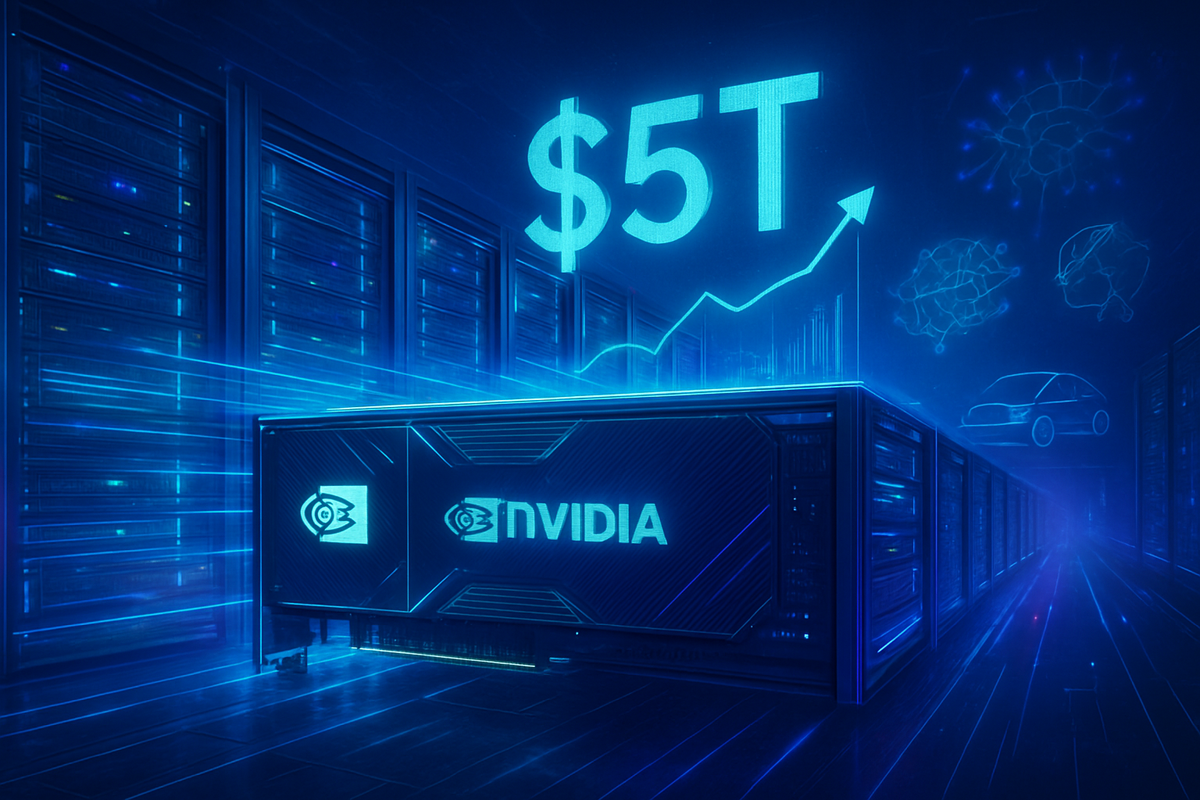
As of October 2025, Nvidia (NASDAQ: NVDA) stands on the precipice of a historic $5 trillion market valuation, a testament to its unparalleled dominance in the artificial intelligence (AI) and high-performance computing (HPC) sectors. This monumental achievement, which has seen its market capitalization soar past $4.5 trillion and, at times, briefly surpass tech giants like Apple and Microsoft to become the world's most valuable company, signifies a profound shift in global technology and investor priorities. The immediate implications are far-reaching, solidifying Nvidia's role as the foundational technology provider for the global AI revolution and reshaping industry landscapes.
Nvidia's meteoric rise is driven by an insatiable demand for its Graphics Processing Units (GPUs) and its proprietary CUDA software platform, which together form the bedrock of modern AI infrastructure. This unprecedented growth highlights the escalating capital flowing into AI compute power, with Nvidia's valuation now exceeding the combined market cap of all major US and Canadian banks. The company's strategic investments in high-growth AI startups and its expansion into new frontiers like robotics and autonomous vehicles further underscore its ambition to maintain long-term relevance and diversification in a rapidly evolving technological ecosystem.
The AI Juggernaut: Unpacking Nvidia's Unprecedented Ascent
Nvidia's journey to a multi-trillion-dollar valuation is underpinned by its undisputed leadership in the AI chip and data center segments. The company commands an impressive market share of over 90% in discrete GPUs for data centers and more than 80% in GPUs used for AI model training and deployment. Its hardware innovations, such as the Ampere architecture (2020) and the more recent Blackwell architecture (announced March 2024), are considered the industry's "gold standard," driving substantial capital expenditures from cloud providers and enterprises worldwide. The upcoming Rubin CPX GPU, expected in H2 2026, promises further performance enhancements, ensuring Nvidia remains at the forefront of AI hardware.
Beyond cutting-edge hardware, Nvidia's proprietary CUDA platform, launched in 2006, has been a critical enabler. This parallel computing platform and programming model creates a powerful competitive moat, ensuring developers remain deeply integrated into Nvidia's technology stack. The company's strategic diversification into areas like autonomous vehicles with its DRIVE AGX platform (adopted by Toyota (NYSE: TM), Hyundai Motor Group (KRX: 005380), and Mercedes-Benz Group AG (FWB: MBG)), robotics via Omniverse, and healthcare through collaborations with IQVIA (NYSE: IQV) and Illumina (NASDAQ: ILMN), further bolsters its growth trajectory.
The timeline of Nvidia's market cap milestones is nothing short of extraordinary: surpassing $1 trillion in mid-2023, $2 trillion in February 2024 (taking only nine months to double), and exceeding $3.3 trillion by June 2024. By July 2025, it crossed the $4 trillion mark, solidifying its position as the first company globally to achieve this. Key players driving this success include Jensen Huang (Founder, President & CEO), whose visionary leadership and unconventional management style have fostered relentless innovation, and Colette Kress (EVP & CFO), who has skillfully navigated the company's financial strategy amidst explosive growth. Major external stakeholders include hyperscale cloud providers like Alphabet (NASDAQ: GOOGL), Amazon (NASDAQ: AMZN) (AWS), and Microsoft (NASDAQ: MSFT) Azure, alongside strategic partners like OpenAI, which announced a multi-billion-dollar deal in September 2025 to deploy gigawatts of Nvidia systems. The market's reaction has been largely celebratory, recognizing Nvidia as the "torchbearer of the AI rally," though some scrutiny exists regarding its premium valuation.
Winners and Losers in Nvidia's Wake
Nvidia's ascent towards a $5 trillion valuation sends significant ripples through the financial markets, creating both immense opportunities for its partners and formidable challenges for its competitors. Its dominance in AI hardware and software, particularly its pervasive CUDA ecosystem, dictates the strategic positioning of numerous public companies.
On the winning side, Taiwan Semiconductor Manufacturing Company (TSMC) (NYSE: TSM) stands as a crucial beneficiary. As Nvidia's primary foundry, TSMC manufactures the advanced GPUs essential for AI, with Nvidia's contribution to TSMC's revenue projected to rise significantly. Hyperscale Cloud Service Providers (CSPs) such as Microsoft (NASDAQ: MSFT), Amazon (NASDAQ: AMZN) (AWS), and Alphabet (NASDAQ: GOOGL) (Google Cloud) are Nvidia's largest customers, heavily deploying its GPUs to power their AI services. While these giants are also developing in-house AI chips to diversify, their reliance on Nvidia's technology for core AI infrastructure remains substantial. Companies like CoreWeave (CRWV) and Applied Digital (APLD), which build and operate data centers housing Nvidia GPUs, also benefit immensely. Furthermore, software and AI development platforms like Palantir Technologies (NYSE: PLTR), which integrate Nvidia's computing technologies, and automotive companies leveraging Nvidia's DRIVE AGX platform, such as General Motors (NYSE: GM) and Toyota (NYSE: TM), are well-positioned to gain.
Conversely, Nvidia's market power poses significant challenges for direct competitors. Advanced Micro Devices (AMD) (NASDAQ: AMD), Nvidia's most direct rival in high-performance GPUs, continues to fight an uphill battle against the entrenched CUDA software ecosystem despite its competitive Instinct MI300X accelerators. Intel Corporation (NASDAQ: INTC), historically dominant in CPUs, has struggled to gain significant traction in the AI chip market, largely playing catch-up with its Gaudi accelerators. However, a recent $5 billion investment by Nvidia into Intel for AI integration could signal a more complex, co-dependent future. New entrants like Qualcomm Incorporated (NASDAQ: QCOM) are pushing into the AI data center market with new chips (AI200 and AI250) targeting AI inference, but Nvidia's lead in training remains strong. Chinese AI chipmakers like Cambricon Technologies (SHA: 688256) also face an intense competitive environment, exacerbated by geopolitical tensions and export restrictions that have impacted Nvidia's market access in China.
Wider Significance: A New Era of Tech Dominance
Nvidia's potential $5 trillion valuation in October 2025 is not merely a financial milestone; it represents a tectonic shift in the global technology landscape, fundamentally reshaping industry trends in AI, semiconductors, and cloud computing. This valuation underscores Nvidia's role as the indispensable "picks and shovels" provider for the AI gold rush, with its GPUs forming the backbone of AI development and deployment globally.
The company's near-monopoly in the AI GPU market (an estimated 94% share as of Q2 2025) has profound ripple effects. For competitors like AMD and Intel, it intensifies pressure to innovate and carve out niche markets, while for hyperscalers like Google and Microsoft, it spurs internal development of custom AI accelerators to reduce dependency. The broader supply chain, heavily reliant on Taiwan Semiconductor Manufacturing Company (TSMC) (NYSE: TSM) for advanced chip manufacturing and ASML for critical lithography equipment, faces increased scrutiny due to geopolitical tensions, particularly between Taiwan and China. These dependencies highlight the fragility of the global tech ecosystem in the face of political instability and trade restrictions.
Nvidia's accelerating market power inevitably raises significant regulatory and policy implications. Antitrust concerns are intensifying globally, with governments scrutinizing the market dominance of "Big Tech." Nvidia's control over both hardware and the pervasive CUDA software ecosystem presents a formidable target for such concerns, as it creates high barriers to entry and limits competition. Furthermore, AI chips have become a matter of national security, leading to increased government scrutiny and export restrictions, notably impacting Nvidia's sales to China. Historically, Nvidia's rapid growth rate has surpassed what giants like Apple and Microsoft achieved in their early years, establishing a new precedent for value creation driven by foundational technological infrastructure in a transformative era.
What Comes Next: Navigating the Future of AI
Following its potential $5 trillion valuation, Nvidia faces a dynamic landscape of short-term opportunities and long-term strategic imperatives. In the immediate future (2025-2026), demand for its Blackwell-based GPUs, with partner products debuting in late 2025, is expected to remain robust. Nvidia's expansion into "sovereign AI" projects, building national AI infrastructures, is projected to generate billions in revenue, further diversifying its growth avenues. The gaming segment, while smaller, will also see a boost with upgrades like the GeForce NOW featuring the RTX 5080.
Longer-term (2027-2030 and beyond), Nvidia's strategy hinges on continuous innovation with architectures like Rubin (H2 2026) and Rubin Ultra (2027), targeting burgeoning markets in enterprise AI, autonomous vehicle commercialization, and edge AI computing. These areas alone could represent a total addressable market exceeding $500 billion by 2030. To sustain this trajectory, Nvidia must continue its strategic pivots: deepening vertical integration with its CUDA ecosystem, forging key partnerships (e.g., with OpenAI and Intel), and relentlessly focusing on energy efficiency in its chip designs.
However, significant challenges loom. The competitive landscape is intensifying with rivals like Advanced Micro Devices (AMD) (NASDAQ: AMD) and Intel Corporation (NASDAQ: INTC) re-entering the AI chip race, and Qualcomm Incorporated (NASDAQ: QCOM) making a strong push into AI inference. Cloud giants like Amazon, Google, and Microsoft are also developing their own custom AI accelerators, posing a threat to Nvidia's market share. Geopolitical tensions, particularly U.S. export controls on advanced AI chips to China, present a substantial headwind, forcing Nvidia to adapt its market strategies. Potential scenarios range from a bullish outlook with sustained 20%+ revenue growth and stock price targets reaching $1,200-$1,500 by 2030, to a bear case involving significant regulatory headwinds, intensified competition, and a slowdown in AI adoption, potentially leading to a dip in stock price.
A New Benchmark: Nvidia's Lasting Impact on the Market
Nvidia's journey towards a $5 trillion market valuation is more than just a financial success story; it's a defining moment for the global technology market. The company has not merely participated in the AI revolution but has actively spearheaded it, establishing a new paradigm in computing where specialized accelerators and robust software ecosystems drive innovation. This unprecedented growth underscores that AI is a foundational, transformative shift, fundamentally altering market valuations and investor priorities towards the core compute power enabling this new era.
The implications for the market moving forward are profound. Nvidia's dominance has intensified competition, prompting rivals to innovate and cloud giants to develop their own custom chips, fostering a dynamic and rapidly evolving AI hardware landscape. It has also highlighted the critical geopolitical importance of advanced semiconductors and the intricate dependencies within the global supply chain, particularly concerning Taiwan Semiconductor Manufacturing Company (TSMC) (NYSE: TSM). The sheer scale of Nvidia's valuation inevitably brings increased regulatory scrutiny, as governments grapple with the market power and strategic significance of AI technology.
Nvidia's lasting impact will be its enduring role as the foundational enabler of accelerated computing across a vast spectrum of applications—from AI and data centers to autonomous vehicles and robotics. Its ability to consistently deliver performance gains and expand its software platform ensures its critical position in shaping the global technological infrastructure for years to come. Investors should closely monitor hyperscaler capital expenditure reports, Nvidia's upcoming earnings announcements (Q3 FY26 expected around November 19, 2025), new product launches (Blackwell and Rubin architectures), and shifts in the competitive landscape, particularly the advancements of rivals and the impact of custom AI chip development by cloud providers. Geopolitical developments and macroeconomic factors will also continue to play a crucial role in shaping Nvidia's trajectory and the broader AI sector.
This content is intended for informational purposes only and is not financial advice






